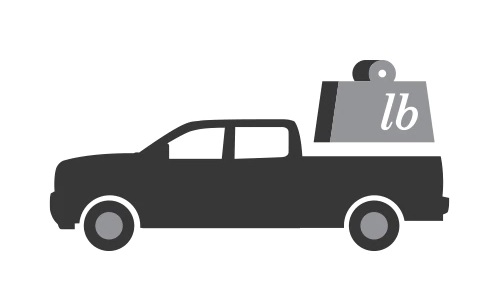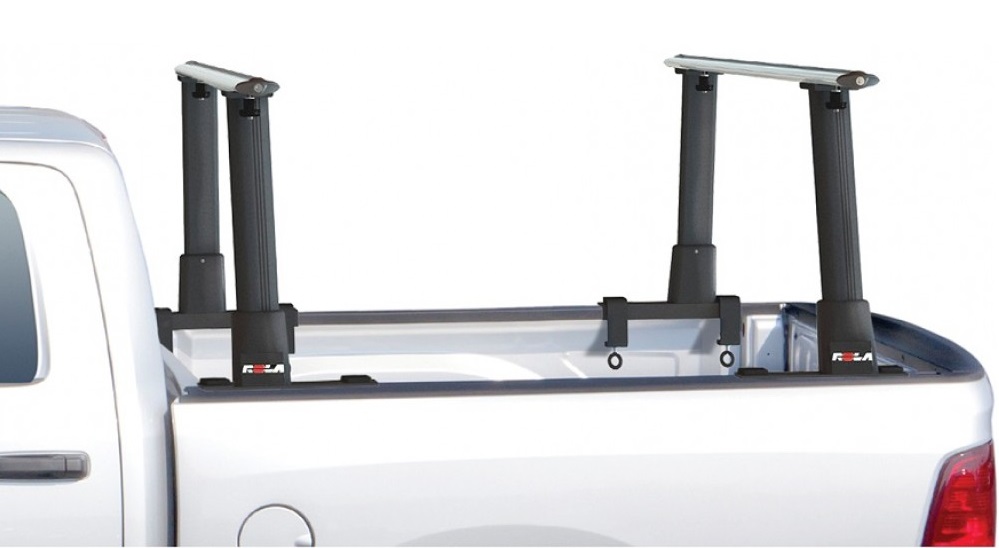
Payload Capacity - How to Get Most Out of Your Truck
Knowing how much payload your vehicle can handle is crucial for safety considerations. The payload is simply any load carried by truck. It helps you to define how much you can fit in your truck and how many trips you need to take. And before you count up everything you'd like to put in your vehicle, remember - passengers count as payload, also.Terms Related to Payload Capacity
Here're some terms that you should know. They all relate to the payload, and you'll probably come across them when buying a truck or towable travel trailer.- Curb Weight - It's the weight of the vehicle, as delivered to you from the manufacturer. It includes all of the standard gear for that model, along with any fluid required to run the engine (coolants and oils). In some cases, it includes a full gas tank;
- Dry Weight – As the name hints, it’s the weight of the vehicle without any of the consumable liquids;
- Gross Vehicle Weight (GVW) – The GVW includes cargo weight, passenger weight, and base curb weight. The base curb weight is all equipment that comes with the vehicle, including a filled gas tank, but not equipment, cargo, and passengers;
- Gros Vehicle Weight Rating (GVWR) – The Gross Vehicle Weight Rating is simple the maximum GVW that the vehicle is built for. Your Gross Vehicle Weight should never be higher than your GVWR since then you’re overloading the truck;
- Gross Combination Weight (GCW) – It includes full trailer along with GVW. It’s the maximum weight that your vehicle is allowed to move along the road. Including itself, towed trailer, cargo, and passengers.
What is Payload Capacity?
Payload capacity refers to all the cargo weight that you can add in addition to your truck’s curb weight (also known as empty weight). A payload can be anything from a truck bed full of dirt to 5 passengers and other things. It’ s calculated by the vehicle manufacturer and noted in the owner’s manual. But you can calculate the truck’s payload capacity by doing a little math: Start with the maximum total weight the truck can handle, known as its Gross Vehicle Weight Rating (GVWR). GVWR is also defined by the manufacturer and is listed in your owner's manual. Subtract the vehicle's curb weight from its GVWR, and you get the payload capacity!Payload Capacity = Gross Vehicle Weight – Curb Weight
For instance, if your vehicle's GVWR is 10,000 lbs, and it weighs 4,000 lbs empty, then your payload capacity is 6,000 lbs. You can put 6,000 pounds of stuff and people in your truck.
Here’re some standard payloads that you might carry with the truck:
- One-half cubic yard of mulch (300 to 400 lbs);
- One-half cubic yard of dirt (1,000 lbs).
- One-quarter cord of firewood (1,250 lbs);
- One-half cubic yard of gravel (1,200 to 1,450 lbs);
- One-half cubic yard of sand (1,300 to 1,500 lbs).

What is Truck Payload?
Payload shows the total weight capacity of a truck, while the payload capacity limits the total amount of cargo that a truck can bear. The weight of passengers and engine fluids affect the payload capacity, too. If a vehicle has a payload capacity of one ton, it means that all weight loaded onto the truck — from passengers, engine fluid and cargo — must not overstep 2,000 pounds. Therefore, if 400 pounds are taken up by the combined weight of the driver, the passenger, and various engine fluids, the truck bed and cab will have the capacity for an additional 1,600 pounds. If you load a series of things in the truck bed that each surpasses 150 pounds in weight, it’ll quickly use up the payload space.Read More
- Motor Oil Explained
- GVWR - Definition, Purpose and How to Determine Gross Vehicle Weight Rating
- Towing Capacity Guide- Meaning, Goal, and How to Increase It
- CNG Cargo Vans: Eco-Friendly
- Fleet Management Software - Benefits and Best Solutions
- 5 Warning Signs Your Car Needs Maintenance
- Why Buying Ex-Fleet Vehicles Is a Good Idea
- Pickup Truck or a Cargo Van
How Much Weight Can the Truck Hold?
On a truck, the manufacturer’s sticker lists the payload capacity, which can either be found inside the driver-side door or in the glove compartment. If you want to increase the GVWR of the vehicle, these are the first places to look. Another place to see it is in the owner’s manual. It’s important to know the difference between payload and tow load. While the tongue weight of a trailer draws upon the strength and engine power of the vehicle, a trailer has its own payload capacity that won’t weight upon the payload of the truck.
How to Increase Truck Payload Capacity
Knowing your truck's payload is great, but what if you need to carry more? Is this possible? Yes, since all truck manufacturers offer optional towing packages for their models. What's in packages can vary from one manufacturer to the next, but they typically improve the performance of the tow truck and include extra tools for better towing. Moreover, you can improve a truck’s payload capacity using these tools and methods.Upgrade the rear springs
The truck's full weight is distributed evenly atop the four springs that support the suspension along with each tire. Consequently, the rear springs bear far more pressure with a loaded vehicle. Rear springs come in two main types – the leaf spring and the coil spring. Springs are rated according to the amount of the load that they can support for a given vehicle. And, both variants of the springs can be upgraded to maximize a vehicle's payload capacity. With coil spring kits, the overall strength of the spring is defined by its thickness. The ticker the toil, the greater benefit it’ll be to a vehicle’s payload performance. If the preexisting coils for your vehicle’s rear suspension are inadequate, replace them with thicker coils.
With leaf springs, the overall strength is defined by the number of the springs. Most leaf springs contain three or four contoured leafs and a flat, supportive leaf at the bottom.
One of the best methods to make a leaf spring stronger is to add an extra leaf to each side of the truck's rear suspension system. It’ll help you to reach the max. payload of your truck.

Use coil-over shock absorbers
The purpose of coil-shock absorbers is to remove the factors of swaying and vibration from the driving experience. Shock absorbers will help you maximize the payload of the truck since an unstable vehicle can be dangerous to drive when loaded its full capacity. If your vehicle has trouble driving straight when fully loaded, the task of hauling boxes, appliances, and furnishings can be hazardous. With shock absorbers, a truck can fulfill one of its primary goals. Granted, coil-over shock absorbers come in different types. Before you choose a pair of shock absorbers, it’s crucial to know whether the absorbers in question are suited for your truck. Check the owner's manual of the truck to see which kind of shock absorbers is adequate for you.Alternatively, you can check a product guide for a particular brand to see whether they will work with your truck's suspension system.
Install a longer bed truck
According to the size of a truck, it'll have either a shorter or longer bed. When you increase the size of the bed, a truck gets more space in the back for larger items. A longer truck bed can maximize payload capacity by leveling the transfer of weight across the truck. While a short bed concentrated a lot of pressure right above the rear suspension, the extended bed area will allow weight to transfer more evenly between the far point of the vehicle's middle section.Add bed racks
Another method to increase space in the trucks' bed is to add bed racks, which mount to the vehicle on one side and work as bunk space for the carrying of items. With side-mounted bed racks, you can free-up space in the truck bed for additional boxes and furnishings. Bed racks can enhance the payload of a truck by providing extra storage space. The arms of bed racks spread above the rear-view of the trucks, and it produces more horizontal storage capacity than a truck bed could allow. They can be used as a singular storage enhancement to the back of a truck or used in combination with truck-bed extension for the full expansion to your payload.
